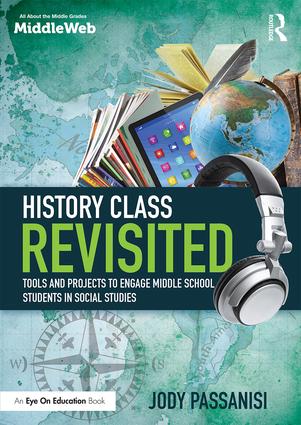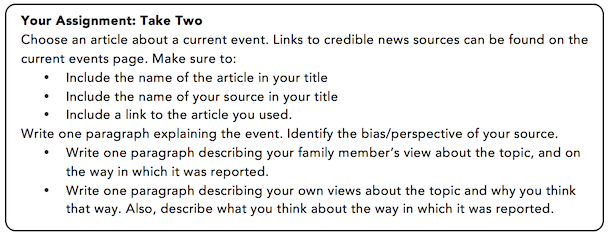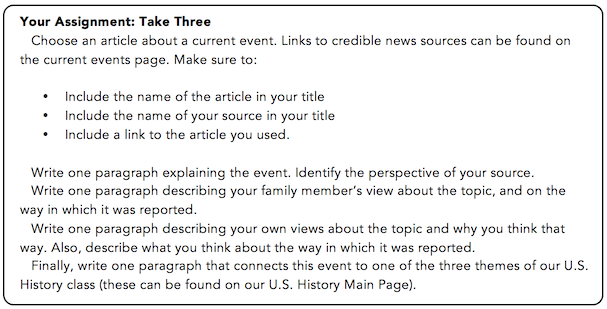Ideas to Blend History and Current Events
Who cares about right now?
One of the most difficult but most important ways to make history relevant to students is to have them look hard at what is taking place in the world today and connect these ideas to both the content and skills that are being worked on in class. I also want my students to understand that today’s news is tomorrow’s history.
My middle school students do a current events project each month. I try to have students bring parents, siblings, grandparents, aunts, uncles or guardians into the conversation in a meaningful way so that the adults in each student’s life can see the work that the student is able to do, and so that the student can discuss complicated topics with others, rather than just on their own.
This assignment is scaffolded. First, students find an article, give their opinion, and discuss another person’s opinion. At this point, students are just finding a particular current event and evaluating it to their best ability in conversation with an adult. I provide them with a list of pre-approved news sources at our current events page, making sure that these sources cover multiple perspectives on the political spectrum.
The next time that they do the assignment, I make it more challenging: They have to look at the way in which the article was reported. To do this, they will often have to look at more than one article to get the full picture. This requires students to pick articles that have a bit more substance. Then they continue to evaluate the event and discuss it with an adult.
Finally, I have students do all of the above, but then also tie the current event into one of our course themes:
► The idea of America has been associated with the ideals of freedom, equality, and opportunity; the ideals do not always reflect reality.
► The United States functions by maintaining a balance between opposing groups/powers.
► The use, disuse, and misuse of new technologies are crucial in shaping the events in a country’s history.
This helps students see that current events are becoming part of their own history, and that current events tie to these themes that we have been examining throughout the year. No matter how you organize your history curriculum (by themes, standards, etc.), you can have students tie current events to something they’re studying so they can make these connections.
Making history matter in middle school
Middle school students need to be reeled in and made to care about the content, but sometimes they are hard to hook. How do we get them to care? There isn’t just one strategy, but having them connect the past to the present is often the best way to do it.
Current events occasionally do strike a chord in middle school students, so discussing them is paramount—especially if it’s something they’re interested in. If it’s difficult to connect a current event to the content you’re covering in class, try to connect it to a concept they’ve studied previously, or even better, have the students try to connect it.
And don’t forget scaffolding and support; middle school students need help to be able to contextualize history. Timelines and maps help, but for the “making them care” part, you have to get students to feel something.

And the study of people, which I write about in Chapter 7 of my book History Class Revisited, is also a really important way to help students connect to the “who-ness” of history.
Teacher self-reflection questions about current events
- How do you make history relevant to your students?
- In what ways do you bring current events into your classroom?
- What kinds of difficult conversations have you had in your history classroom? What tools have you used to help facilitate those conversations?
- What strategies from this chapter are you thinking of utilizing?
- What adjustments might you need to make for your own classroom and the needs of your students?
Feature image: USDOD retro voting poster, 2012

































This might sound like a dumb question, but I want to be clear on it. The way I understand it, students are picking a different article for each take?
Not at all, Wesley; thanks for reading! Yes, each month is a new article. In some ways it would be interesting to use the same article and keep adding to its depth– but it seems prudent to look at more current events and scaffold the skills with each.
Would you give me an example of what the second assignment is asking: to look at the way in which the article is reported? I’m not sure what this would look like. I am hoping to make more ties between current events and our class content, and this scaffolding method could be really helpful!
Thanks for reading, Barbara! In addition to an explanation of what the article is talking about, students would also look at any particular perspective the person writing the article or the news source seemed to have. For example, if the student was reading an article about the recent tragic and unfortunate event at the Cincinnati Zoo, the student would look at what adjectives the article used to describe the event itself, the parents, the death of the gorilla– which witnesses they spoke to and how it backs up what seems to be the article’s thesis. In other words: what does the author of the article think about the event and how do you know? Please let me know if this helps!
Wonderful ideas, Jody! It is so important to teach students not only current events, but perspectives. They love to throw out the word “bias” but they don’t really understand it. This assignment is a great way to scaffold towards that goal, starting with understanding the “bias” of their parents. Thanks for sharing!
Hello again, could you share what links you have students go to for relevant and credible current event articles? Thank you
Hi Wesley– it’s good to hear from you again. Usually I suggest for my students, since they are in 8th grade, to look at the Los Angeles Times, the San Jose Mercury News, San Francisco Chronicle (since we are in CA), or the NY Times, the Washington Post, etc. If you want to be more discerning in your curation, I suggest https://newsela.com; they have relevant and kid-friendly articles about current events.
This article was fantastic Jody!